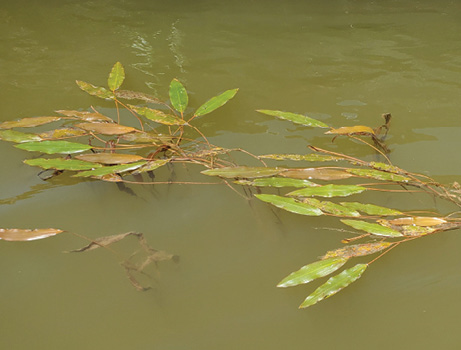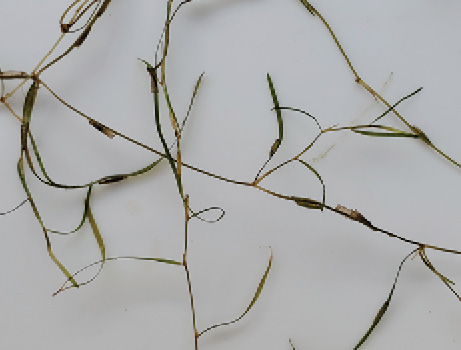Pondweeds | Potamogeton spp.
Submersed | Native and Non-Native



There are native and non-native pondweeds in Mississippi, and both can interfere with pond use. Known by the common name “pondweed,” there are many species, and they are quite varied in appearance. The leaves may be submerged or floating on the water surface.
One confusing characteristic of pondweeds is that submersed leaves are thinner, somewhat translucent, and positioned alternately along the stem, while floating leaves are more elliptical, oval, or lance-like, leathery, and sometimes positioned somewhat opposite of one another. When visible, veins on the leaves are parallel and run the length of the leaf.
The flowers are a key characteristic yet often overlooked. Flowers are greenish-brown and composed of four rounded segments that form an oblong or ball-like spike. The fruits are round, green or brown, and tiny, usually less than 0.3 of an inch.
Some species, like leafy pondweed (P. foliosus), are mostly submerged and can be confused with southern naiad (Najas spp.). Other species, like American pondweed (P. nodosus), can cover the water surface with leaves up to 8 inches long.
Management Value
This family of plants can be an important part of healthy ecosystems. Pondweeds are an important food for ducks, beavers, snails, insects, and other animals. Because most species remain at relatively low densities, they provide important habitat for fish and are a favorite location for anglers.
Many management agencies have programs to establish Potamogeton in large reservoirs that lack aquatic plants. Likewise, some of these species can be advantageous to establish in private waters.
Under most conditions they do not cause problems, but some species can be problematic (e.g., curly-leaf pondweed; P. crispus). American pondweed is a good candidate for introduction and can be easily managed with herbicides.
Recommended Controls
Option 1: Triploid Grass Carp. Stock 5 to 10 grass carp per acre to reduce moderate pondweed infestations; stock 15 or more per acre for severe infestations. Note that abundant grass carp can impact other fish and can live up to 20 years.
Stock 8- to 10-inch triploid grass carp in ponds that have established largemouth bass populations.
Option 2: Endothall (4.23-pound formulation). Endothall (1.92 gallons per acre-foot of water) should be applied as a submersed injection (application using a wand or hose). Determine pond volume prior to application. Do not exceed annual herbicide rate limits as stated on the product label.
Option 3: Fluridone (4.0-pound formulation). Fluridone should be applied as a submersed injection (0.85 ounce per acre-foot of water). Determine pond volume prior to application. Do not exceed annual herbicide rate limits as stated on the product label.
Option 4: Penoxsulam (2.0-pound formulation). Penoxsulam should be applied as a submersed injection (3.5 ounces per acre-foot of water). Determine pond volume prior to application. Do not exceed annual herbicide rate limits as stated on the product label.
NOTE: Acre-foot = average depth of pond multiplied by pond acreage; average depth is calculated by taking the depth at 20 points across a water body and averaging the values.
Treat ponds when the plants are actively growing and the water temperature is at least 60˚F. For larger water bodies, it is best to treat one-third of the pond at a time. There should 2 weeks or more separating applications. After the entire pond has been treated, a repeat whole-pond application may be necessary to eliminate remaining plants.
Read and follow all chemical label instructions, especially the section on the use of personal protection equipment.

The information given here is for educational purposes only. References to commercial products, trade names, or suppliers are made with the understanding that no endorsement is implied and that no discrimination against other products or suppliers is intended.
Publication 3735-10 (POD-11-23)
By Wes Neal, PhD, Extension/Research Professor, Wildlife, Fisheries, and Aquaculture; Dennis Riecke, Fisheries Coordinator, Mississippi Department of Wildlife, Fisheries, and Parks; and Gray Turnage, PhD, Assistant Research/Extension Professor, GeoSystems Research Institute.
The Mississippi State University Extension Service is working to ensure all web content is accessible to all users. If you need assistance accessing any of our content, please email the webteam or call 662-325-2262.



